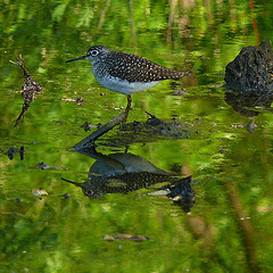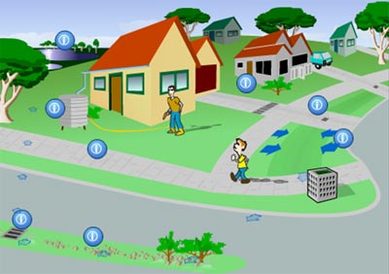The Water Cycle
Activity 1:
(a) Go to the Ferguson Foundation's Water on the Move website [http://www.fergusonfoundation.org/hbf/watercycle/flash.shtml]. Watch the animation and complete the interactive matching activity. Read the information at Ways of a Watershed [http://www.fergusonfoundation.org/hbf/raindrop_roadtrip/index.shtml] and write a narrative describing the adventures of the raindrop - don't stop at the Atlantic Ocean - include evaporation and condensation in your story.
OR
(b) Watch the introduction to the water cycle at Thirstin's Water Cycle[http://www.epa.gov/ogwdw/kids/flash/flash_watercycle.html]. In your workbook, draw a square divided into four quarters. Write down the four separate sections of the cycle in the square below:
Watch the animation again and add the following words in the correct quarters of the square: precipitation, runoff, evaporation, condensation, water vapour, transpiration, accumulation. Add an image that illustrates each process.
(c) Having trouble understanding this topic? Try the home experiments at the bottom of the Kidzone activities [http://www.kidzone.ws/water/]
Watch the animation again and add the following words in the correct quarters of the square: precipitation, runoff, evaporation, condensation, water vapour, transpiration, accumulation. Add an image that illustrates each process.
(c) Having trouble understanding this topic? Try the home experiments at the bottom of the Kidzone activities [http://www.kidzone.ws/water/]
Extension for GAT Students
This site [http://ga.water.usgs.gov/edu/watercycle.html] has a mega-image of all the parts of the cycle. Click on the individual part for details and issues surrounding each part of the water cycle. Create an annotated diagram which shows how the water cycle operates in Auburn.
The Role of Wetlands

Activity 3
Read the fact sheets about wetlands at Nature's Kidneys[http://www.gould.org.au/garden/content/12/PDF/FactSheet.pdf] and Wetlands Reef Beat [http://www.gbrmpa.gov.au/__data/assets/pdf_file/0005/18482/wetlands_posters.pdf]. Some functions of wetlands are listed below. After reading, rank these functions from most to least important for (a) the built environment and (b) the natural environment. A wetland can:
Thinking question: Why might it be important to maintain wetlands around city waterways?
Image: 'more sandpiper' http://www.flickr.com/photos/17046340@N00/2466906369
INSERT ONE NOTE FILE OF list!
Read the fact sheets about wetlands at Nature's Kidneys[http://www.gould.org.au/garden/content/12/PDF/FactSheet.pdf] and Wetlands Reef Beat [http://www.gbrmpa.gov.au/__data/assets/pdf_file/0005/18482/wetlands_posters.pdf]. Some functions of wetlands are listed below. After reading, rank these functions from most to least important for (a) the built environment and (b) the natural environment. A wetland can:
- filter out decaying plants and animals
- reduce amount of nitrogen from storm water
- provide food and nesting sites for migrating birds
- trap rubbish from urban run off
- oxygenate water
- prevent erosion along waterways
- provide recreation space for local residents
- create a buffer zone against flooding
- provide a habitat for threatened or endangered plants and animals
- prevent sediment build-up in streams
Thinking question: Why might it be important to maintain wetlands around city waterways?
Image: 'more sandpiper' http://www.flickr.com/photos/17046340@N00/2466906369
INSERT ONE NOTE FILE OF list!
Wetlands and the Water Cycle

Activity 4
Read Melbourne Water's Introduction to Urban Wetlands[http://education.melbournewater.com.au/content/rivers_and_drainage/wetlands_-_natures_filter/wetlands_-_natures_filter.asp]. This article outlines the function of wetlands and explains how Melbourne Water is improving the water supply by providing places for runoff to return to the river systems.
Scroll down and click on "Follow the stormwater..."[http://education.melbournewater.com.au/applications/wsud/index.html] to find out how designers of new housing developments (urban planners) are contributing positively to the water cycle in cities. How many of these features are used in Auburn? [Conversation Starter: Why do the streets around Auburn Station use paving stones instead of concrete]
(a) Make a list of urban features which assist with the collection of run-off and rank them from most to least important advantages of good urban planning.
(b) Write a letter to Auburn council advocating (giving the advantages of) good urban planning. Make sure you recommend at least five of the features identified on the Melbourne Water website and explain why they are important for the Auburn area..
Read Melbourne Water's Introduction to Urban Wetlands[http://education.melbournewater.com.au/content/rivers_and_drainage/wetlands_-_natures_filter/wetlands_-_natures_filter.asp]. This article outlines the function of wetlands and explains how Melbourne Water is improving the water supply by providing places for runoff to return to the river systems.
Scroll down and click on "Follow the stormwater..."[http://education.melbournewater.com.au/applications/wsud/index.html] to find out how designers of new housing developments (urban planners) are contributing positively to the water cycle in cities. How many of these features are used in Auburn? [Conversation Starter: Why do the streets around Auburn Station use paving stones instead of concrete]
(a) Make a list of urban features which assist with the collection of run-off and rank them from most to least important advantages of good urban planning.
(b) Write a letter to Auburn council advocating (giving the advantages of) good urban planning. Make sure you recommend at least five of the features identified on the Melbourne Water website and explain why they are important for the Auburn area..